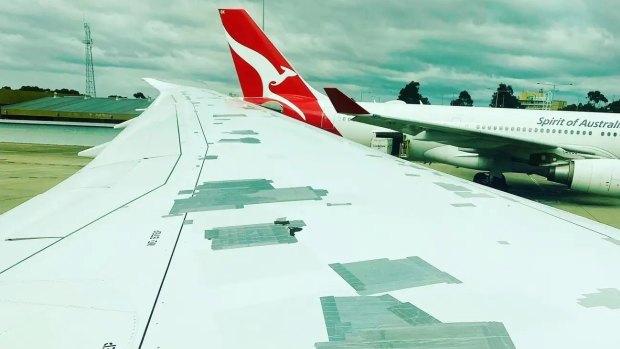This was published 1 year ago
What is speed tape? Why your plane's wing looks like it's patched up with duct tape
By James Bikales

A concerned plane passenger's post of what appears to be duct tape on a plane's wing went viral. Credit: David Wakeham/Twitter
Looking out of your plane's window and seeing what looks like duct tape patching up the wings is not a reassuring sight.
Several concerned passengers in recent years have posted photos on social media of taped planes, including a traveller in Australia who tweeted a photo of a Qantas tape-covered wing last month.
While it appears to be duct tape, what you're seeing on aircraft wings is actually an aluminum-based material known in the aviation world as speed tape, and it's perfectly safe for certain types of repairs, according to aviation experts and the Federal Aviation Administration.
"There's never going to be a piece of garden-variety duct tape used on an airplane," said John Nance, a veteran pilot and safety consultant. "So if you're looking at it, it's called speed tape and it's very, very specifically designed to do whatever it is they're trying to make it do."
Speed tape is extremely durable, able to withstand up to 600 mph winds and extreme environmental changes if properly applied, according to Nance. 3M says its version of the tape is rated from minus-65 to 300 degrees Fahrenheit and able to withstand moisture, flame, UV rays and chemicals.
The tape is primarily deployed when weathering has caused a part to be exposed to the airstream. The plane is safe to fly, but the airline wants to prevent any further weathering until it can repair the part, Nance said.
"It is not something that would be used to hold together two parts of the airplane," he said. "This is usually skin, but you don't want anything peeling back further than it might already have started peeling back."
Nance added that airlines "don't want to use it any more than they have to," especially where it is visible to passengers.
"There's just no way this day and time to explain to passengers - they think you're holding the airplane together with baling wire and Scotch tape," he said.
Speed tape is safe to use "for temporary, minor repairs to nonstructural aircraft components," an FAA spokesperson said in a statement. Each airline spells out approved uses of the tape in its maintenance manual, which subsequently must be approved by the FAA, according to the spokesperson.
In 2002, the FAA fined United Airlines $US805,000 for flying 193 flights with improperly applied speed tape. While the airline's maintenance manual permitted use of the tape, the agency said a United mechanic had applied it on holes that were too big and close to the edge of the spoiler; the airline contested the fine, saying the aircraft were safe to fly.
The aircraft in the recent photo from Australia appears to be a Boeing 787, which could explain the use of the speed tape. The FAA has flagged a largely cosmetic issue with peeling paint on Boeing 787s due to damage from UV rays.
A Boeing spokesperson said in a statement that a "small number of 787s" have experienced issues with paint adhesion and that one of its recommended temporary solutions is the use of speed tape. The company is developing a new coating that would alleviate the issue.
While aircraft are generally safe to fly with speed tape, Nance suggested any traveller who is concerned with a part of the plane should ring their call button and ask the flight attendant to tell the pilot to explain the issue.
Nance said his career has been saved three times by passengers alerting him to a problem with the plane, including a woman who spotted a massive fuel leak on a DC-8 he was flying out of Lima, Peru, years ago.
"We would not have made landfall had she not seen that," Nance said. "I think most pilots have stories like that - you're part of our eyes and ears back there."
The Washington Post
See also: How a tiny insect can cause a plane to crash
See also: To what extent do fuel costs affect plane ticket prices?
Sign up for the Traveller newsletter
The latest travel news, tips and inspiration delivered to your inbox. Sign up now.